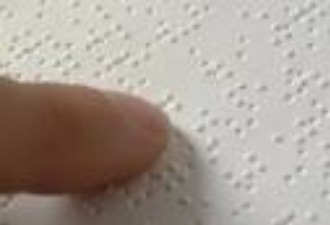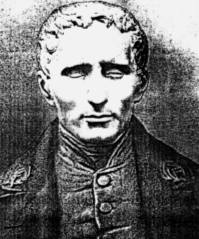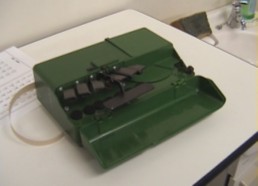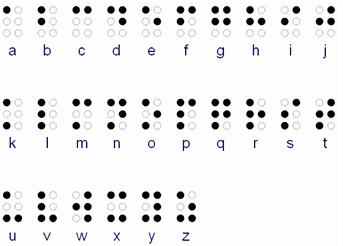Editorial
The case study below is one in the series on this subject in HLT. Aleksandra Frankowska joins now Anna Hyzniak, Maciej Sienkiewicz and Anna Jarosz who have already published their case studies in HLT (Nov. 2007 and Sept.2006 respectively). All of them and many other students from English Unlimited Teacher Training College in Gdańsk, Poland, were involved in a project in which they observed SEN children learning English and other subjects along with children with no special educational needs. The project was supervised by Hanna Kryszewska, HLT Editor.

Case study - Teaching Blind Children
Aleksandra Frankowska, Poland
Aleksandra Frankowska is a graduate from Teaching Training College in Gdańsk. She is currently a CLIL teacher of English through Art at Amerykańsko-Polskie Stowarzyszenie Oświatowe in Gdynia (American Primary School). e-mail: metaliczna2@wp.pl

The school I have visited is Gdyńska Szkoła Społeczna. It offers education in small classes, paying special attention to needs of individual students. It is the only school in the Gdynia, Sopot, Gdańsk area that specialises in teaching blind or nearly blind students. The school is equipped in Braille machines, magnifying machines. There is a Braille inscription on the door of each class, the toilette or even coffee machine. There are also a variety of clubs, such as: history club, dancing club or ecology club and many more. For blind students there is a guide provided that teaches them how to express themselves through body language or how to walk with a stick and find their way in the street.
There is also a variety of methods used in the education programme of the sighted students. These include:
- 'ortofrajda' - colourful spelling, this includes subscribing certain and set colours to some letters: ż, rz, ó, u, ch, h, exceptions. ( Polish spelling is very complex). It is said to be a non-stressing method of learning through seeing and hearing. It helps in building creative thinking and decreases the influence of dyslexia.
- 'professor's Bogdanowicz method' - working with dyslexic students; materials, handouts are student- friendly: hand-written in capital letters, A4 format of copybooks, small pictures in the tests.
- 'Veronica Sherborne's method' - based on physical exercises concentrated on ' cutting' the middle axis of the body, such as doing 'scissors' with arms or legs or drawing X. It also includes drinking water during the lesson and massaging the palate with the tongue. It works best with ADHD students and children with low self-esteem.
- 'Denison's method' - it undergoes the general term of ' Metoda Dobrego Startu' (Good Start Method); it includes working with children who have specific difficulties in Math, reading and writing learning.
The class I have visited is the 6th grade. There is one blind boy, whom I have observed, a two nearly blind children that use magnifying glasses and various machines to help them. Many other children from this class suffer from ADHD, dyslexia and general learning difficulties. There is also a girl who suffers from muscle decline and is in a wheelchair. The class seemed to be very integrated, children helped each other on a regular basis. They did their best to work hard during the lessons despite their disabilities and difficulties.
The boy I have observed has been blind since the day he was born. However, he is very bright, intelligent and has an exceptional memory. He writes and reads in Braille but only in Polish. When it comes to English, his main learning device is a recording machine. He tried to write in English but he does it only phonetically: 'I' is written like this 'aj' ( as Polish learner would write it in Polish). Sometimes he decides not to take part in the lesson and he doesn't speak at all. Despite this, he seems to be extremely attentive when it comes to listening. Even when his peers asked the teachers for some vocabulary, he was able to answer all the questions. At times when he seems not to take part in the lesson, he doesn't disrupt other students, as it would normally be the case with inattentive students.
He seems to posses an extra sense; even without seeing he can recognise who is absent in the class the very first moment he enters the class. He also relies on the sense of touch; sometimes one may feel a bit intimidated because he may touch one accidentally in the places that are intimate. However, it must be understood that this helps him to identify a person and feel his/her presence, not only hear a voice somewhere in the air. What is rather peculiar is that he chooses people he talks to, not only among other children but also among teachers.
He has loving parents, but his role model is his grandfather, who has a very dominating and strong character. The granddad tells him about 'Solidarność' and John Paul II which make him interested in history. He has told me that he even went to Lech Wałęsa, former President of Poland, to talk to him. In his free time, he likes to play the keyboard, especially the songs of Krawczyk, Elvis Presley or Roy Orbison. It can be assumed that he likes these artists because of his grandfather's taste. His age would rather suggest that he would prefer popular music. The boy himself and his English teacher said that he has a typically American accent because of the songs he listens to.
During the English lesson the class read a text about a gardening competition, they answered couple of questions to the text and those asked by the teacher. The blind boy was only listening as the materials weren't adapted to his disability. The teacher asked whether he had a garden. At first he was reluctant to answer but when the teacher had already given up he said he didn't have it. He then translated it into Polish, which he absolutely loves. He is good at it. When the teacher was asking him some questions she was using a variety of tones and pitches, and hearing these the boy was smiling, laughing and participating more.
The topic of the lesson shifted to food and recipes. The class got handout with pictures and their recipes in Polish and they had to translate these into English. The blind boy didn't get any handout written in Braille but the teacher came to him and asked him about his favourite fruit. He was answering very slowly, thinking every name over very carefully. He was also holding the teacher's hand, as if he was reassuring himself that he is talking with a real person. Again, he was translating every word said either by the teacher or by him into Polish.
After the lesson, he stayed in class and talked to me. He suggested that he would write something in Braille for me. He was writing very quickly. He wrote his name and surname and that he liked Elvis. This was all in Polish. I suggested writing something in English. He immediately exclaimed that he couldn't, so I said I could spell him the words in English. I was spelling and he was writing his favourite songs' titles, including 'Love me tender' and 'Pretty Woman'. The boy told me that at home his Braille machine is electric and even 'says' the words that he writes down.
The second lesson I have observed was a Polish lesson. The class was writing a re-take of a test. The nearly blind girl was using a magnifying machine, after she had finished writing the test she was even reading text messages through it. The boy I have observed was also writing a test, the teacher was reading for him the questions and he was writing the answers in Braille. Sometimes the teacher needed to repeat the questions or the examples again, but most of the time he was answering quickly as if he was seeing the test somehow. The teacher later explained that she was reading a bit louder so that other students, especially those with dyslexia, could hear what is written, because it is of great help to these students.
To my mind, the school I have visited is well adapted to the needs of blind students. The staff are skilled in writing and reading in Braille. What I found rather depressing is that after finishing such a school, blind students cannot complete higher education because most of the educational institutions lack special programmes adapted to the needs of blind people.
The boy I have observed was cheerful and had his dreams, one was to win a music contest. I also asked him whether he read in English in Braille, to my surprise he said there were no such books available to him. Even though he has never had the chance to see the world, to see his face, to see his family he seems to be well adapted to life. He takes as much as he possibly can from it. I think one could learn from him how to appreciate life and things one has and from others who suffer from any other disability.
Louis Braille
Invented an alphabet through which blind people can read and write. He became blind at the age of three, after an accident in which sewing needles got into his eyes.

Typical Braille Machine

Braille Alphabet


Please check the Expert Teacher course at Pilgrims website.
Please check the Methodology and Language for Primary Teachers course at Pilgrims website.


|